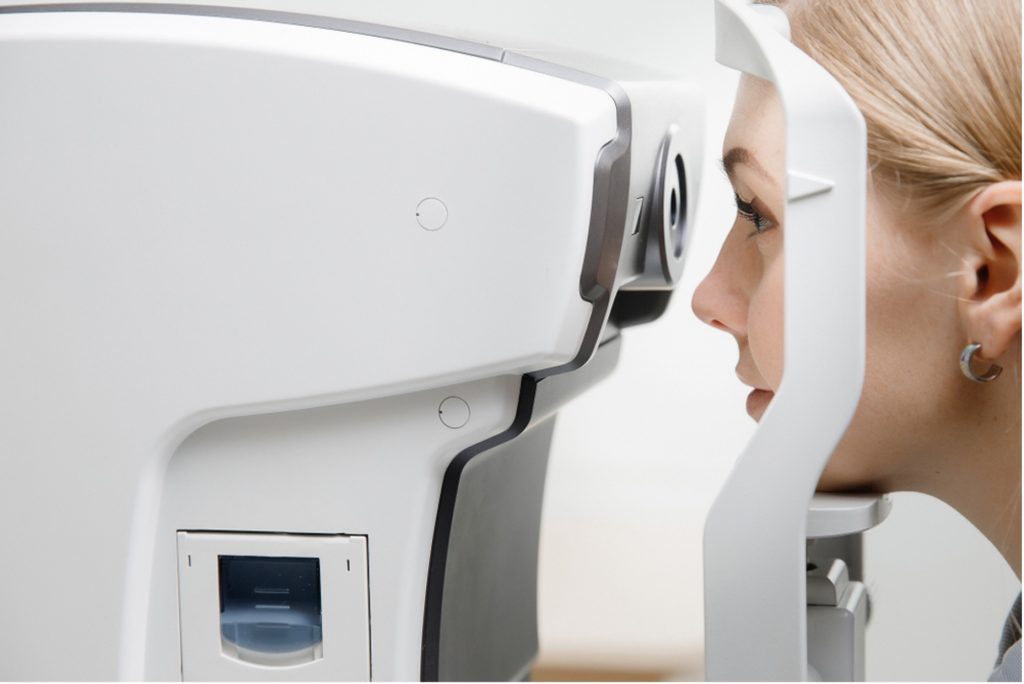Posted on: 20 September, 2021
Sight is one of our most important senses. With many people citing loss of vision as one of their biggest fears. When caring for your eyes, to ensure that they are both healthy and providing you clear vision, there are a number of eye conditions to be aware of. Early detection and regular eye examinations will be critical in treating and preventing further damage to your eyes and potentially even loss of sight.
Whether you are near sighted, farsighted or have an astigmatism, these are all categorised as refractive errors. Usually corrected very easily with a prescription for lenses, in the form of either spectacles and/or contact lenses. Symptoms of a refractive error will usually include blurry vision, headaches, dry or tired eyes etc.
AMD is the leading cause of blindness in the UK. There are two types of AMD known as wet and dry. An OCT can help to identify the earliest signs of AMD, determine the type and monitor its progress over time. Symptoms of AMD include:
In glaucoma the optic nerve is damaged. This is the part of the eye that connects with the brain. This damage causes gradual loss to your peripheral vision. Early stages of chronic glaucoma do not cause symptoms, and so regular eye examinations are essential to detecting glaucoma at its earliest stage.
Cataracts form when the clear lens inside your eye becomes cloudy. This can result in blurry or hazy vision and will worsen gradually. They are quite typical of the ageing process. If you begin to notice these symptoms it is very important you consult either your Optometrist or your doctor.
When the eye doesn’t produce enough tears, it may cause dry eye symptoms. These symptoms may include the eye watering, a gritty sensation or feeling that there is something in the eye. Your Optometrist can provide helpful treatment advice for dry eye, so booking an appointment at your optician, is best advised.
OCT technology can be used during an eye examination to make a detailed assessment of the eye health. This allows for the Optometrist to access three-dimensional, cross-sectional views of the retina and generate accurate records for future reference. These scans are vital in the diagnosis of numerous eye conditions and can help your Optometrist determine the best treatments. Regular eye examinations are very important in detecting the early signs of common eye concerns, so be sure to book your next appointment at one of our branches.
Sight is one of our most important senses. With many people citing loss of vision as one of their biggest fears. When caring for your eyes, to ensure that they are both healthy and providing you clear vision, there are a number of eye conditions to be aware of. Early detection and regular eye examinations will be critical in treating and preventing further damage to your eyes and potentially even loss of sight.
Whether you are near sighted, farsighted or have an astigmatism, these are all categorised as refractive errors. Usually corrected very easily with a prescription for lenses, in the form of either spectacles and/or contact lenses. Symptoms of a refractive error will usually include blurry vision, headaches, dry or tired eyes etc.
AMD is the leading cause of blindness in the UK. There are two types of AMD known as wet and dry. An OCT can help to identify the earliest signs of AMD, determine the type and monitor its progress over time. Symptoms of AMD include:
In glaucoma the optic nerve is damaged. This is the part of the eye that connects with the brain. This damage causes gradual loss to your peripheral vision. Early stages of chronic glaucoma do not cause symptoms, and so regular eye examinations are essential to detecting glaucoma at its earliest stage.
Cataracts form when the clear lens inside your eye becomes cloudy. This can result in blurry or hazy vision and will worsen gradually. They are quite typical of the ageing process. If you begin to notice these symptoms it is very important you consult either your Optometrist or your doctor.
When the eye doesn’t produce enough tears, it may cause dry eye symptoms. These symptoms may include the eye watering, a gritty sensation or feeling that there is something in the eye. Your Optometrist can provide helpful treatment advice for dry eye, so booking an appointment at your optician, is best advised.
OCT technology can be used during an eye examination to make a detailed assessment of the eye health. This allows for the Optometrist to access three-dimensional, cross-sectional views of the retina and generate accurate records for future reference. These scans are vital in the diagnosis of numerous eye conditions and can help your Optometrist determine the best treatments. Regular eye examinations are very important in detecting the early signs of common eye concerns, so be sure to book your next appointment at one of our branches.

Copyright 2024 R. Woodfall. All rights reserved.